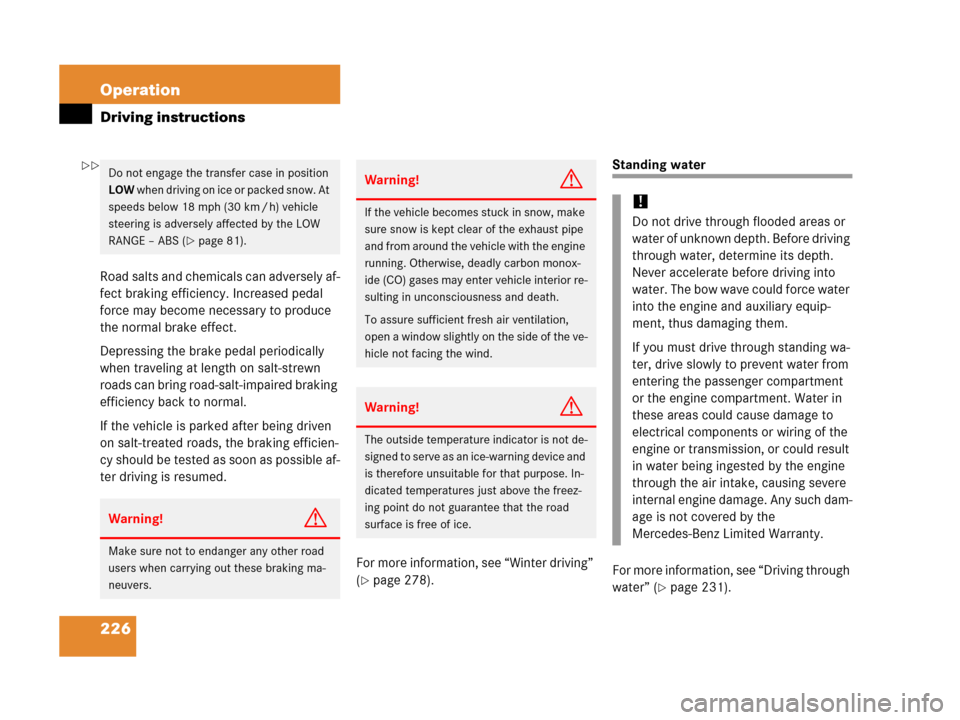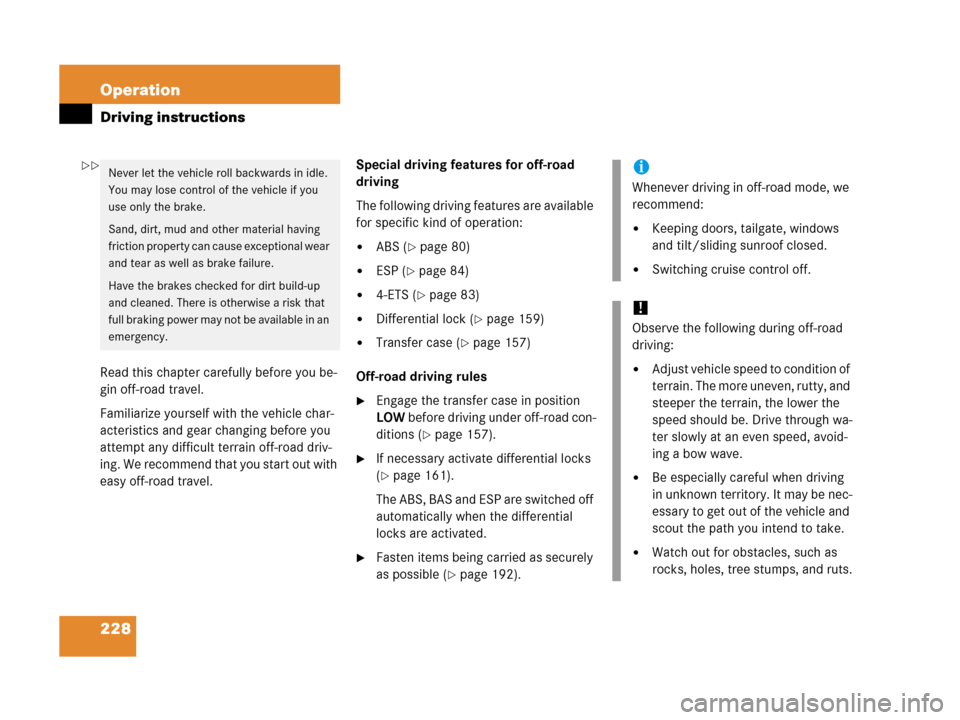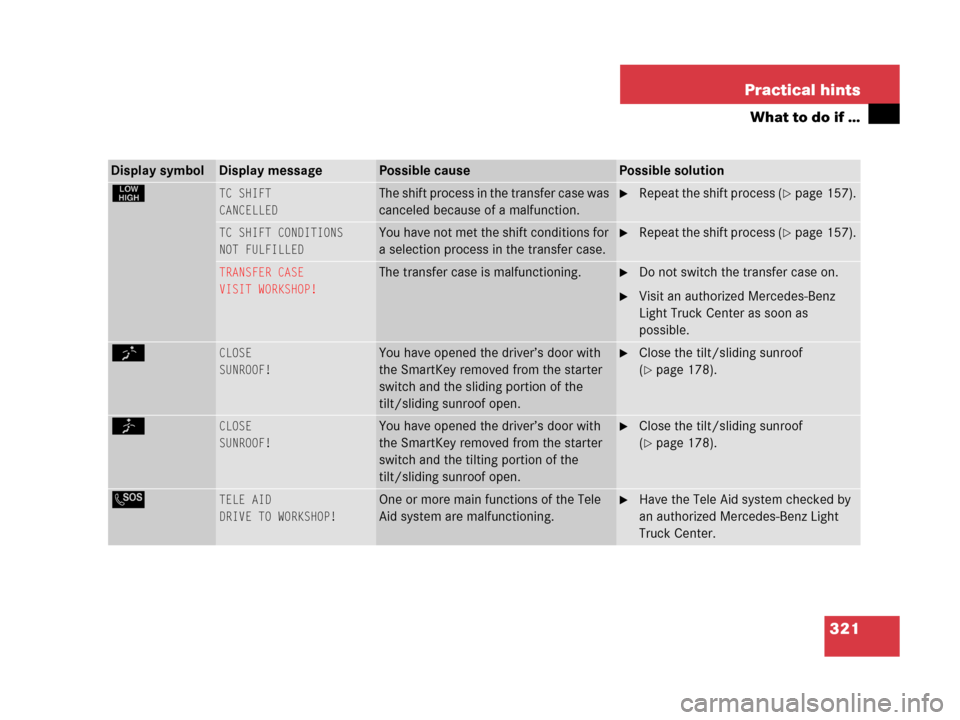Page 220 of 417
219 Operation
The first 1000 miles (1500 km)
All of the above instructions, as may apply
to your vehicle type, also apply when driv-
ing the first 1000 miles (1500 km) after the
engine, the transfer case, the front differ-
ential or the rear differential has been re-
placed.i
G55AMG:
For better protection of the front and
rear differential, the oil must be
changed after a break-in period of
1900 miles (3000 km).
Changing oil in the front and rear
differential increases the service life
and helps reduce noise from the
differential locks.
See Maintenance Booklet for additional
information and Factory Approved
Service Products pamphlet for informa-
tion on the approved service product
required to perform the front and rear
axle oil change.
i
Always obey applicable speed limits.
Page 227 of 417

226 Operation
Driving instructions
Road salts and chemicals can adversely af-
fect braking efficiency. Increased pedal
force may become necessary to produce
the normal brake effect.
Depressing the brake pedal periodically
when traveling at length on salt-strewn
roads can bring road-salt-impaired braking
efficiency back to normal.
If the vehicle is parked after being driven
on salt-treated roads, the braking efficien-
cy should be tested as soon as possible af-
ter driving is resumed.
For more information, see “Winter driving”
(
�page 278).
Standing water
For more information, see “Driving through
water” (
�page 231).
Do not engage the transfer case in position
LOW when driving on ice or packed snow. At
speeds below 18 mph (30 km / h) vehicle
steering is adversely affected by the LOW
RANGE – ABS (
�page 81).
Warning!G
Make sure not to endanger any other road
users when carrying out these braking ma-
neuvers.
Warning!G
If the vehicle becomes stuck in snow, make
sure snow is kept clear of the exhaust pipe
and from around the vehicle with the engine
running. Otherwise, deadly carbon monox-
ide (CO) gases may enter vehicle interior re-
sulting in unconsciousness and death.
To assure sufficient fresh air ventilation,
open a window slightly on the side of the ve-
hicle not facing the wind.
Warning!G
The outside temperature indicator is not de-
signed to serve as an ice-warning device and
is therefore unsuitable for that purpose. In-
dicated temperatures just above the freez-
ing point do not guarantee that the road
surface is free of ice.
!
Do not drive through flooded areas or
water of unknown depth. Before driving
through water, determine its depth.
Never accelerate before driving into
water. The bow wave could force water
into the engine and auxiliary equip-
ment, thus damaging them.
If you must drive through standing wa-
ter, drive slowly to prevent water from
entering the passenger compartment
or the engine compartment. Water in
these areas could cause damage to
electrical components or wiring of the
engine or transmission, or could result
in water being ingested by the engine
through the air intake, causing severe
internal engine damage. Any such dam-
age is not covered by the
Mercedes-Benz Limited Warranty.
��
Page 229 of 417

228 Operation
Driving instructions
Read this chapter carefully before you be-
gin off-road travel.
Familiarize yourself with the vehicle char-
acteristics and gear changing before you
attempt any difficult terrain off-road driv-
ing. We recommend that you start out with
easy off-road travel.Special driving features for off-road
driving
The following driving features are available
for specific kind of operation:
�ABS (�page 80)
�ESP (�page 84)
�4-ETS (�page 83)
�Differential lock (�page 159)
�Transfer case (�page 157)
Off-road driving rules
�Engage the transfer case in position
LOW before driving under off-road con-
ditions (
�page 157).
�If necessary activate differential locks
(
�page 161).
The ABS, BAS and ESP are switched off
automatically when the differential
locks are activated.
�Fasten items being carried as securely
as possible (
�page 192).
Never let the vehicle roll backwards in idle.
You may lose control of the vehicle if you
use only the brake.
Sand, dirt, mud and other material having
friction property can cause exceptional wear
and tear as well as brake failure.
Have the brakes checked for dirt build-up
and cleaned. There is otherwise a risk that
full braking power may not be available in an
emergency.i
Whenever driving in off-road mode, we
recommend:
�Keeping doors, tailgate, windows
and tilt/sliding sunroof closed.
�Switching cruise control off.
!
Observe the following during off-road
driving:
�Adjust vehicle speed to condition of
terrain. The more uneven, rutty, and
steeper the terrain, the lower the
speed should be. Drive through wa-
ter slowly at an even speed, avoid-
ing a bow wave.
�Be especially careful when driving
in unknown territory. It may be nec-
essary to get out of the vehicle and
scout the path you intend to take.
�Watch out for obstacles, such as
rocks, holes, tree stumps, and ruts.
��
Page 235 of 417

234 Operation
Driving instructions
Returning from off-road drivingOff-road driving increases strain on the ve-
hicle.
We recommend that you inspect the vehi-
cle for possible damage after each off-road
trip. Recognizing any damage and a subse-
quent timely repair reduces the chance of
a possible breakdown or accident later on.
Proceed as follows:
�Switch the transfer case in position
HIGH (
�page 157).
�Disengage differential locks
(
�page 162).
�Remove excessive dirt from tires,
wheels, wheel housings, and under-
body.
For instance, after driving in mud, clean
the radiator, chassis, engine, brakes,
and wheels from extreme dirt using a
strong jet of water.
�Inspect frame, oil pan, brake hoses,
etc., as well as vehicle underbody for
possible damage.
�Check tires for possible damage and
remove foreign objects. Clean all exte-
rior lamps and conduct a brake test.
Warning!G
Never drive on pavement with activated dif-
ferential locks. Engaged front axle differen-
tial locks limits ability to move around
curves.
If you feel a sudden significant vibration or
ride disturbance, or you suspect that possi-
ble damage to your vehicle has occurred,
you should turn on the hazard warning flash-
ers, carefully slow down, and drive with cau-
tion to an area which is a safe distance from
the roadway.
Inspect the tires and under the vehicle for
possible damage. If the vehicle or tires ap-
pear unsafe, have it towed to the nearest
Mercedes-Benz Light Truck Center or tire
dealer for repairs.
Damage to the vehicle negatively influences
driving comfort and poses the risk of acci-
dent to you and other drivers.
Page 321 of 417
320 Practical hints
What to do if …
Display symbolDisplay messagePossible causePossible solution
DRIVE TO WORKSHOP!The seat belt system is malfunctioning.�Visit an authorized Mercedes-Benz
Light Truck Center as soon as
possible.
§TC IN NEUTRALNo gear has been selected in the transfer
case, it is in NEUTRAL.�Engage transfer case to gear position
HIGH or LOW (
�page 157).
Warning!G
If the transfer case is in NEUTRAL, the
Pposition of the transmission will not hold
the vehicle. The parking brake must be ap-
plied to hold vehicle in place.
Page 322 of 417

321 Practical hints
What to do if …
Display symbolDisplay messagePossible causePossible solution
§TC SHIFT
CANCELLEDThe shift process in the transfer case was
canceled because of a malfunction.�Repeat the shift process (�page 157).
TC SHIFT CONDITIONS
NOT FULFILLEDYou have not met the shift conditions for
a selection process in the transfer case.�Repeat the shift process (�page 157).
TRANSFER CASE
VISIT WORKSHOP!The transfer case is malfunctioning.�Do not switch the transfer case on.
�Visit an authorized Mercedes-Benz
Light Truck Center as soon as
possible.
K CLOSE
SUNROOF! You have opened the driver’s door with
the SmartKey removed from the starter
switch and the sliding portion of the
tilt/sliding sunroof open.�Close the tilt/sliding sunroof
(
�page 178).
J CLOSE
SUNROOF! You have opened the driver’s door with
the SmartKey removed from the starter
switch and the tilting portion of the
tilt/sliding sunroof open.�Close the tilt/sliding sunroof
(
�page 178).
L TELE AID
DRIVE TO WORKSHOP! One or more main functions of the Tele
Aid system are malfunctioning.�Have the Tele Aid system checked by
an authorized Mercedes-Benz Light
Truck Center.
Page 361 of 417

360 Practical hints
Towing the vehicle
Transporting the vehicle
When transporting the vehicle, you can use
the towing eyes for pulling the vehicle onto
a trailer or transporter.
�Move the gear selector lever to posi-
tion N.
�Shift the transfer case to neutral posi-
tion N.
�To avoid damaging the vehicle, it
should only be tied down on the
wheels / wheel rims, not on chassis
components such as the transverse
link or trailing arm.Towing the vehicle - various problem
scenarios
�Comply with all towing information
(
�page 358).
In case of engine damage, transmission
damage or malfunctions in electrical
equipment
�Move the gear selector lever to posi-
tion N.
�Shift the transfer case to neutral posi-
tion N.In case of transfer case damage or for
towing vehicle distances exceeding
30 miles (50 km)
The propeller shafts to the drive axles must
be removed.
In case of front axle damage
Raise the front axle when towing. The pro-
peller shaft between the rear axle and the
transfer case must be removed.
In case of rear axle damage
When the rear axle is raised, the vehicle
can only be towed with a wheel lift or a dol-
ly placed under its front wheels.
!
When removing drive shaft, place M10
nuts on bolts as distance sleeves and
tighten using M8 nuts.
Always install new self-locking nuts
when reinstalling the drive shaft.
Page 377 of 417

376 Technical data
Fuels, coolants, lubricants, etc.
Capacities
Vehicle components and their respective
lubricants must match.Therefore use only products tested and ap-
proved by Mercedes-Benz.Please refer to the Factory Approved
Service Products pamphlet, or inquire at
an Mercedes-Benz Light Truck Center.
ModelCapacityFuels, coolants, lubricants, etc.
Engine with oil filterG500
G55AMG8.5 US qt (8.0 l)
9.0 US qt (8.5 l)Approved engine oils
Automatic transmission9.0 US qt (8.5 l)MB Automatic Transmission Fluid
Transfer case2.96 US qt (2.8 l)MB part no. A 001 989 28 03 10
Differential lock mechanism0.47 - 0.63 US qt
(0.45 - 0.6 l)Brake fluid DOT 3+4, SAE J1703
Front axleG500
G55AMG1.5 US qt (1.4 l)
1.5 US qt (1.4 l)Hypoid gear oil SAE 85W-90
Hypoid gear oil Castrol SAF-XJ
Rear axleG500
G55AMG1.9 US qt (1.8 l)
1.9 US qt (1.8 l)Hypoid gear oil SAE 85W-90
Hypoid gear oil Castrol SAF-XJ
Power steeringapprox. 1.06 US qt (1.0 l)MB Power Steering Fluid, or
approved Dexron III ATF
Front wheel hubsapprox. 1.5 oz (43 g) eachHigh temperature roller bearing grease
Fuel tank
including a reserve ofG500
G55AMG25.4 US gal (96.0 l)
25.1 US gal (95.0 l)
3.4 US gal (13.0 l)Premium unleaded gasoline:
Minimum Posted Octane 91
(average of 96 RON / 86 MON)